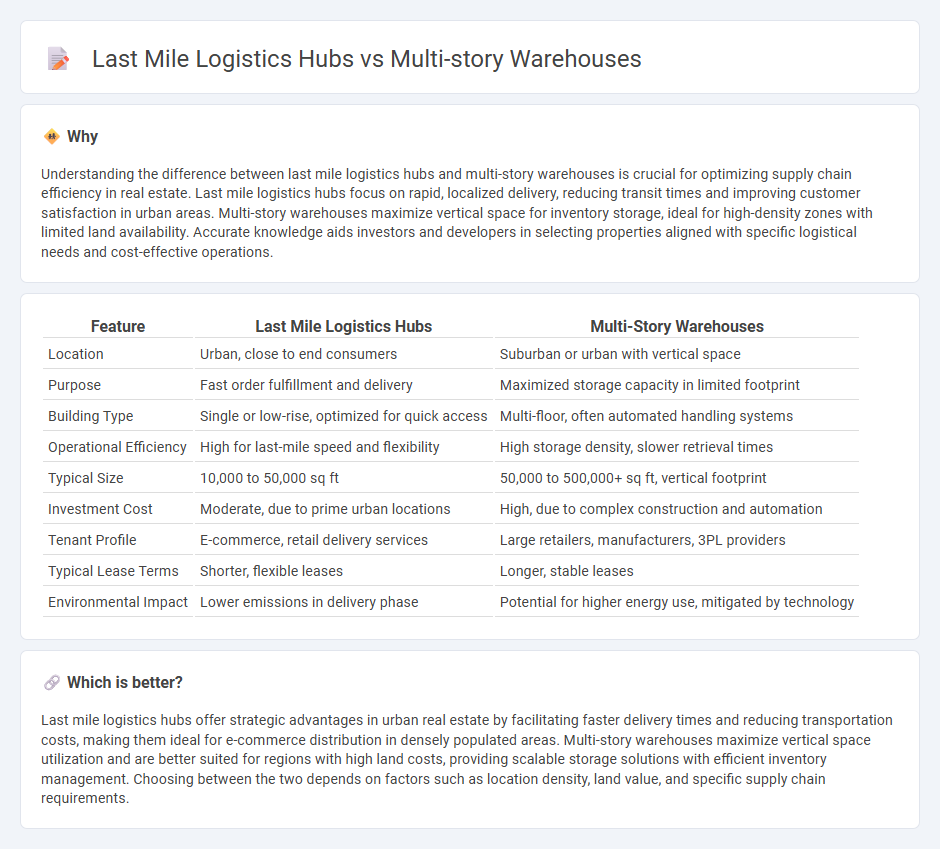
Last mile logistics hubs optimize speed and efficiency by minimizing delivery distances in urban areas, while multi-story warehouses maximize storage capacity through vertical space utilization in densely populated regions. Both real estate solutions address different challenges in supply chain management, balancing accessibility with inventory volume. Explore how choosing the right facility can impact cost, delivery times, and operational scalability.
Why it is important
Understanding the difference between last mile logistics hubs and multi-story warehouses is crucial for optimizing supply chain efficiency in real estate. Last mile logistics hubs focus on rapid, localized delivery, reducing transit times and improving customer satisfaction in urban areas. Multi-story warehouses maximize vertical space for inventory storage, ideal for high-density zones with limited land availability. Accurate knowledge aids investors and developers in selecting properties aligned with specific logistical needs and cost-effective operations.
Comparison Table
| Feature | Last Mile Logistics Hubs | Multi-Story Warehouses |
|---|---|---|
| Location | Urban, close to end consumers | Suburban or urban with vertical space |
| Purpose | Fast order fulfillment and delivery | Maximized storage capacity in limited footprint |
| Building Type | Single or low-rise, optimized for quick access | Multi-floor, often automated handling systems |
| Operational Efficiency | High for last-mile speed and flexibility | High storage density, slower retrieval times |
| Typical Size | 10,000 to 50,000 sq ft | 50,000 to 500,000+ sq ft, vertical footprint |
| Investment Cost | Moderate, due to prime urban locations | High, due to complex construction and automation |
| Tenant Profile | E-commerce, retail delivery services | Large retailers, manufacturers, 3PL providers |
| Typical Lease Terms | Shorter, flexible leases | Longer, stable leases |
| Environmental Impact | Lower emissions in delivery phase | Potential for higher energy use, mitigated by technology |
Which is better?
Last mile logistics hubs offer strategic advantages in urban real estate by facilitating faster delivery times and reducing transportation costs, making them ideal for e-commerce distribution in densely populated areas. Multi-story warehouses maximize vertical space utilization and are better suited for regions with high land costs, providing scalable storage solutions with efficient inventory management. Choosing between the two depends on factors such as location density, land value, and specific supply chain requirements.
Connection
Last mile logistics hubs and multi-story warehouses are interconnected through efficient urban supply chain networks designed to optimize space and reduce delivery times. Multi-story warehouses maximize vertical space in dense urban areas, enabling real estate developers to accommodate high inventory volumes within limited footprints. This integration supports seamless inventory distribution to last mile hubs, enhancing real estate value by improving accessibility and reducing transportation costs in congested city environments.
Key Terms
Vertical Storage Efficiency
Multi-story warehouses maximize vertical storage efficiency by utilizing stacked racking systems and high-rise shelving, significantly increasing storage density per square foot compared to traditional single-level facilities. Last mile logistics hubs prioritize rapid access and distribution, often sacrificing vertical storage to ensure swift product movement and minimized delivery times within urban environments. Explore the trade-offs between vertical storage capacity and operational speed to optimize your supply chain strategy.
Proximity to Urban Centers
Multi-story warehouses offer vertical storage solutions that maximize space efficiency in dense urban areas, significantly reducing the distance to final consumers. Last mile logistics hubs prioritize strategic placement near urban centers to enable rapid delivery and minimize transit times. Discover how proximity influences operational costs and customer satisfaction in modern supply chain strategies.
Delivery Speed
Multi-story warehouses optimize space in urban areas, enabling efficient storage and rapid retrieval of goods, which supports shorter delivery windows in last mile logistics. Last mile logistics hubs are strategically positioned near end consumers to minimize transit times and enhance delivery speed directly to the doorstep. Explore the differences in operational strategies and technological integrations that drive delivery speed improvements in both multi-story warehouses and last mile logistics hubs.
Source and External Links
What is Multi-storey Warehousing? - Marine Insight - This article discusses how multi-story warehouses offer a solution to space and real estate constraints by maximizing floor space and facilitating faster delivery to customers in urban areas.
Are Multi-story Warehouses Becoming the Norm Because of Amazon? - This blog explores how Amazon's significant investment in multi-story warehouses is driving the trend, especially in areas with high land costs and limited space.
Multi-Story Facility Growth Continues | CBRE - This brief discusses the growing demand for multi-story facilities, which remain a niche but increasingly important part of industrial infrastructure in densely populated areas.
 dowidth.com
dowidth.com